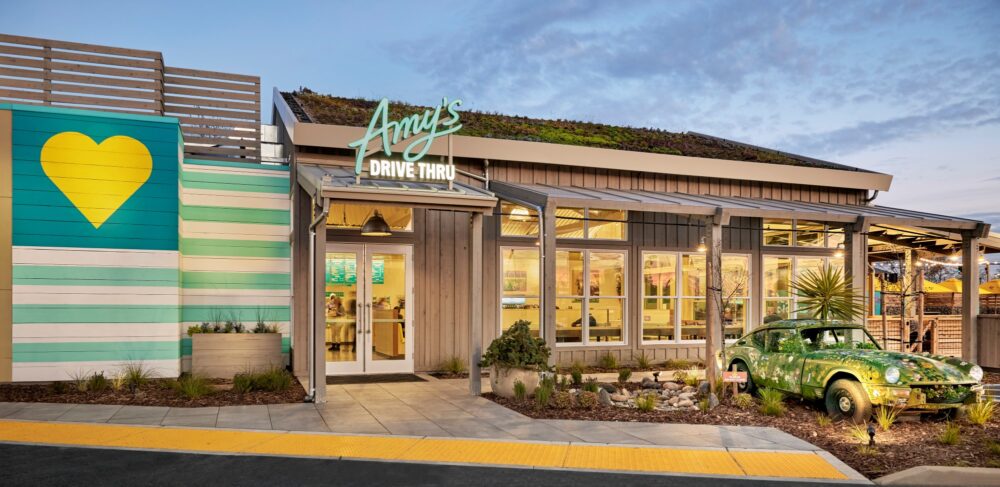
Aria Group has been designing restaurants for over 34 years, but we recently experienced unique challenges while working on Amy’s Drive Thru in Roseville, California. Partnering with a client committed to the environment and social well-being enabled us the opportunity to design a restaurant with a Living Roof. Amy’s is the first Certified B Corporation fast-food restaurant, leading the charge in vegetarian/plant-based options. “Certified B Corporations are leaders in the global movement for an inclusive, equitable, and regenerative economy. Unlike other certifications for businesses, B Lab is unique in our ability to measure a company’s entire social and environmental impact.” – Bcorporation.net. This project strives to educate – showcasing its environmental and social concerns through its teamwork, commitment to climate concerns, and ultimately its design. The following is its story…
 Progress photos of the living roof components
Progress photos of the living roof components
Who?
Designing a Restaurant with a Living Roof was made possible through collaboration with our client and many partners. Our team included: Amy’s Drive Thru, KDC Construction, Clarke and Reilly, Chestnut Company, MFSD+B, Henderson Engineering, Hart Gaugler & Associates, Kier + Wright, Camp & Camp Associates, Inc., and Symbios Ecotecture.
Why?
“The living roof at our Roseville Amy’s Drive Thru is not only beautiful – it also promotes a number of environmental benefits including reduced energy requirements, retention of stormwater on-site, habitat biodiversity and reduction of the heat island effect, just to name a few.” – Jason Dedmore, Director of Real Estate & Development at Amy’s Drive Thru, Inc.
A living roof offers many benefits to a building and the environment. The mass of the soil acts as a great insulator helping to regulate the buildings internal temperature. This allows for less heating or cooling and an overall lower energy bill. The return on investment varies per geographical region but Roseville offered a great opportunity for Amy’s.
 Symbios Ecotecture installing the Living Roof.
Symbios Ecotecture installing the Living Roof.
The soil and plants absorb rainwater and hold it on site versus running off directly into the sewer system. Holding more rainwater onsite reduces strain on the sewer system leading to less flooding. This does create the need for a slightly larger structure to support the roof and more caution with waterproofing the building roof, but Aria worked with Amy’s to celebrate the resulting gabled structure by exposing it inside the dining room and celebrating the design on the interior.
Environmentally, the Living Roof also offers a reduction to the urban heat island effect. Higher temperatures in urban areas leads to higher cooling loads in buildings, increasing the carbon footprint, compounding the Climate Crisis.
Growing plants does take time — see below photos of the plants at restaurant opening and six months later. Plant selection is an important process that Symbios Ecotecture and Camp & Camp teamed up to provide the best options of native species to thrive. The selected plants also create a habitat for pollinators and birds, increasing biodiversity.
 Left photo at restaurant opening by photographer Cesar Rubio. Right photo six month after opening by Symbios Ecotecture.
Left photo at restaurant opening by photographer Cesar Rubio. Right photo six month after opening by Symbios Ecotecture.
How?
The architecture, with cues from agricultural structures, is simple in form, but form follows function in creating various dining opportunities and protecting patrons and employees from Roseville’s climate. The design team chose to have a gabled roof to showcase the Living Roof to patrons and the community, creating a green beacon for Amy’s Drive Thru. A living roof is very much a team effort, affecting not just design but our consulting engineers. By having conversations early and often the team was able to deliver a sustainable end result.
 Partial living roof section by Aria Group
Partial living roof section by Aria Group
What’s next….
Aria Group will continue to innovate and lead by example in keeping social, economic, and environmental concerns top of mind. We are excited to collaborate on designs that continue to enrich our communities and the environment through our designs leading to a more harmonious future with our planet.
Amy’s Drive Thru Roseville recently won an award for Best New Concept Launch by Restaurant Development + Design
Meet the Team: Nathan Kiecker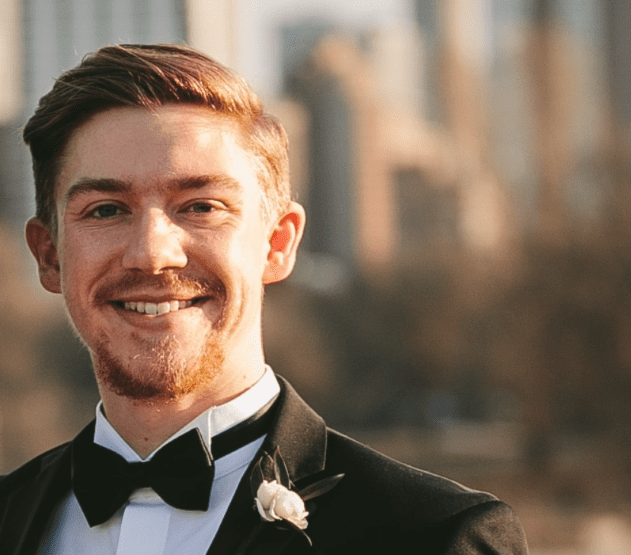
Welcome to another edition of Meet the Team! This month, we would like you to meet Nathan Kiecker. Nathan is an Architectural Designer and has been a part of the Aria Group team since 2019. Recently, Nathan’s focus has been on several Shake Shack projects around the U.S. and his technical talents have been instrumental to several other sports entertainment venues like Topgolf and the Henrico Sports Complex. Rounding out his hospitality experience, Nathan is also on the team that designed three new food & beverage spaces within Chicago’s Museum of Science and Industry. Continue reading to learn more about Nathan!
What project are you most proud of since being at Aria Group? That would be my first project ever: Shake Shack San Francisco Centre. It was a small interior buildout in the Westfield Mall but it taught me the detailed intricacies that smaller projects require when designing in an existing space. I would liken it to mastering a game of Tetris. Being a part of the process was definitely very rewarding specifically in detailing and coordinating an angular design.
Where did you grow up? I grew up, and still live, in Berwyn, Illinois. Berwyn is 10 minutes south of Oak Park where Aria is located so I have been familiar with the area and surroundings all my life. It is really nice being close by our office.
What did you want to be when you grew up and why? Since childhood, I have always wanted to be an architect. It may sound cliché, but being introduced and experiencing Frank Lloyd Wright’s residential work along with his home and studio—just minutes from my own home—was very influential. I took that direction and passion and have built my career toward that goal.
How many siblings do you have and are they anything like you? I have two older sisters Nicole (the oldest) and Nora (Middle) which makes me the baby. A fun fact is our names start with the letter N, and I would say all three of us have design-orientated minds as do our parents, who are both graphic designers. We all followed in their footsteps.
 Nathan and his two older sisters all followed in their parents footsteps with design oriented careers.
Nathan and his two older sisters all followed in their parents footsteps with design oriented careers.
What is something you get overly competitive about and why? Anything sports-related, definitely golf. If I wanted to be completely honest though, I’m competitive when it comes to anything that involves two individuals and an end goal of winning. Being competitive is a personal driver for me but when I’m working with my team – I want my team to be successful first and foremost.
 Nathan is always ready for a competitive game of golf!
Nathan is always ready for a competitive game of golf!
If you could only eat one meal for the rest of your life, what would it be and why? Pasta! I have eaten it so much that now I can make my own sauce from scratch. It’s just one of those easy quick meals that can be made anytime.
What’s the last TV show you binge-watched? Ozark. Season 4, Part 1.
What’s your current favorite TV show? Peacemaker! If you have not seen, or heard of this, do yourself a huge favor and have a blast. Thank me later.
What is in the trunk of your car right now? My golf clubs. I’m always prepared for a round with the boys, weather permitting of course. But then again, that is what Topgolf is for!
What is something most people don’t know about you? I collect sneakers. #Sneakerhead. I have really stepped up my game in the last 5 years. I usually wear beaters during the winter, but when the weather warms up be on the lookout for the heat!
Do you have a favorite travel story? So this is not one of my best stories, but it’s definitely one I’ll always remember. When I was in college I decided to wait in line for the new iPhone (at the time it was the iPhone 6). In-store purchasing started at 6am on a Saturday morning at this particular mall which was roughly 15 miles away from college. I had the bright idea of biking there to be one of the first to purchase. So I left and headed out around 8pm the evening before. Since this part of Michigan did not have many sidewalks or street lights, I had to bike up and down hilly roads overnight holding a flashlight in one hand and cars racing past me. After 2 hours of biking I arrived. Following several cups of coffee at a nearby Denny’s, I headed over to the mall to jump in line. It was incredible how many people rushed in all at once—many of them serial early adopters who always flood Apple stores for the next upgrade. The experience was chaos! Pushing, shoving— pure CHAOS! Even an ambulance arrived to help with injuries. When I finally made it to the front of the line, I learned that I needed my parent to verify the account information. The crazy adventure was all for nothing. Ever since, I happily just order online!
Check out other editions of Meet the Team on our Blog!
Aria Group: Beat the Streets
We are excited to share another successful pro bono project that extends our continued commitment to social responsibility, environmental stewardship, equity and inclusion. Aria Group began collaborating in 2020 with Beat the Streets on their new South Archer Avenue wrestling facility located in the Garfield Ridge neighborhood of Chicago—a project that would transform and directly improve a community by introducing expanded equity programs to reach a larger audience and girls in particular. Beat the Streets Chicago is a nonprofit organization that aims to empower Chicago youth through wrestling. They believe that wrestling has the ability to positively impact both physical health and social emotional learning, creating “Life Champions.” This program, when combined with other in-house enrichment programming, empowers Chicago youth with a pathway to positive life outcomes. We couldn’t be more proud to highlight our continued commitment to take part in such projects that allow us to donate our talent and time through conceptualization and meaningful design solutions.
We worked with Executive Director, Mike Powell, to design a space that fit the needs of this growing organization. The space contains two wrestling rooms, a weight room, a coach’s office, two locker rooms, a referee’s locker room, and a classroom for enrichment programs that include a range of coaching initiatives around test prep and tutoring to mentoring students on financial literacy and nutritional wellness.
Alongside Aria Group, Stages Construction and BTR Engineers donated their time and resources to make this project possible. Aria Group is honored to have been able to aid in the impactful mission behind Beat the Streets. We are excited to see this new facility used to its fullest extent and for the Beat the Streets team to continue with their pivotal role of empowering our Chicago youth.
The Team
Our team for this project consisted of Josh Curvey, Doug Lueken, Lillian Reyes-Brahar, Joe Junius, Katherine Dafcik, and Chris Wilson.
General Contractor: Stages Construction
MEP Engineer: BTR Engineering
Structural Engineer: Hart Gaugler
Meet the Team: Kyle Miller

 Welcome to another edition of Meet the Team! Kyle Miller began at Aria Group in February 2015 as an Architectural Technician and was recently promoted to Project Coordinator. He brings an attention to detail and a positive outlook to every project he works on – we’re lucky to have him as a part of our team! A short list of clients Kyle has worked with include Buddy’s Pizza, Topgolf, Del Frisco’s Double Eagle Steakhouse, Perry’s Steakhouse & Grille, Copa Kitchen & Bar, and Dos Toros Taqueria in Chicago. Kyle is proud to have had the opportunity to help establish Topgolf’s latest single-level concept and his detailing work on the Del Frisco’s Double Eagle Steakhouse in San Diego California. That project helped Aria Group secure the NEWH Top ID award.
Welcome to another edition of Meet the Team! Kyle Miller began at Aria Group in February 2015 as an Architectural Technician and was recently promoted to Project Coordinator. He brings an attention to detail and a positive outlook to every project he works on – we’re lucky to have him as a part of our team! A short list of clients Kyle has worked with include Buddy’s Pizza, Topgolf, Del Frisco’s Double Eagle Steakhouse, Perry’s Steakhouse & Grille, Copa Kitchen & Bar, and Dos Toros Taqueria in Chicago. Kyle is proud to have had the opportunity to help establish Topgolf’s latest single-level concept and his detailing work on the Del Frisco’s Double Eagle Steakhouse in San Diego California. That project helped Aria Group secure the NEWH Top ID award.
 Where and what did you study in undergrad and grad school? I studied at Southern Illinois University in Carbondale where I received my undergrad and graduate degree in Architecture. I was also a graduate assistant in the digital fabrication lab and worked at the Campus Architecture Office.
Where and what did you study in undergrad and grad school? I studied at Southern Illinois University in Carbondale where I received my undergrad and graduate degree in Architecture. I was also a graduate assistant in the digital fabrication lab and worked at the Campus Architecture Office.
Where did I grow up? I grew up in Warrenville, Illinois.
Do you have a child? My wife Colleen and I had our first child, McKenzie Harper, last November. She is the joy of our lives and such a happy little girl.
 Do you have any pets? One dog – she’s spunky and sweet and looks like a teddy bear. Her name is Sadie Mae and has her own Instagram and at one time had more followers than Aria Group. Sadie is 5 years old and is a Havanese.
Do you have any pets? One dog – she’s spunky and sweet and looks like a teddy bear. Her name is Sadie Mae and has her own Instagram and at one time had more followers than Aria Group. Sadie is 5 years old and is a Havanese.
 Best travel story? For our honeymoon we went to Italy. We immersed ourselves into the culture and traveled only by foot or public transit. We stayed only at local bed and breakfasts. We traveled to the Vatican in Rome, did a cooking class with a chef in Florence, explored St. Mark’s Square in Venice, and enjoyed the views in Positano.
Best travel story? For our honeymoon we went to Italy. We immersed ourselves into the culture and traveled only by foot or public transit. We stayed only at local bed and breakfasts. We traveled to the Vatican in Rome, did a cooking class with a chef in Florence, explored St. Mark’s Square in Venice, and enjoyed the views in Positano.
Favorite Restaurant in Chicago? Lou Malnati’s. What is more Chicago than deep dish pizza?
What is your favorite ice cream flavor? Vanilla but that’s because it needs to be paired with brownies or blueberry pie.
What is your drink of choice? Blue Moon Belgian White with an orange slice and a splash of orange juice.
What is something most people don’t know about you? I am a black belt in two styles of martial arts Tang Soo Do and Hapkido. I practiced for 10 years and was an instructor for all ages but loved teaching the little ones.
Check out other editions of Meet the Team on our blog!
Meet the Team: Brian Zielinski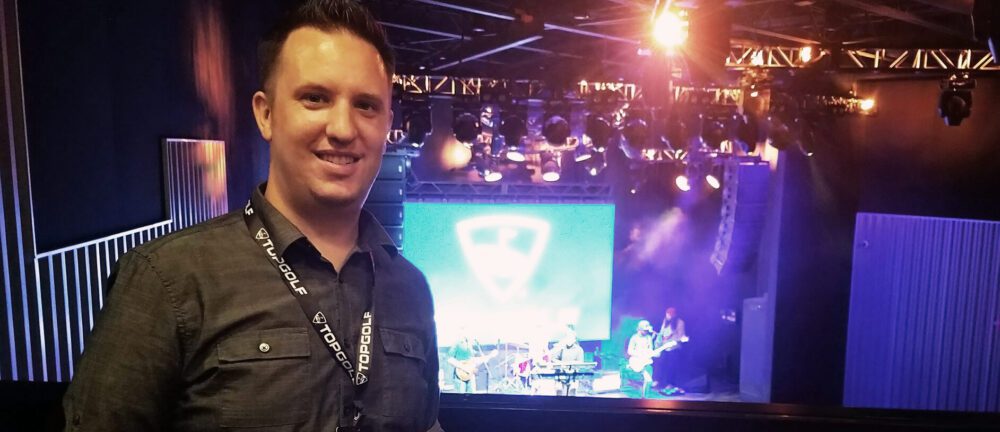
 Welcome to another edition of Meet the Team! Brian Zielinski is a Project Manager at Aria Group who just celebrated 15 years with our firm. He joined our team in 2006 as an Architectural Technician and has been practicing architecture for 17 years. Brian has managed a variety of projects in our office, including Perry’s Steakhouse & Grille, Buddy’s Pizza, Topgolf, and Nando’s. He is currently working on an exciting sports complex that we are designing on the east coast! He says he has a hard time choosing a favorite project as there are so many that standout, but mentions the Topgolf Nashville music venue and Perry’s Steakhouse in Schaumburg. Another that brings back memories is a California Pizza Kitchen in Tempe, AZ, which is where it all started for him at Aria. Fun Fact: Brian almost didn’t study architecture. He credits staying close to his hometown as a main reason that he eventually landed at Aria Group. Lucky for us that Brian made the right decision and our team and our clients have all benefited. To learn about more fun facts about Brian, read on!
Welcome to another edition of Meet the Team! Brian Zielinski is a Project Manager at Aria Group who just celebrated 15 years with our firm. He joined our team in 2006 as an Architectural Technician and has been practicing architecture for 17 years. Brian has managed a variety of projects in our office, including Perry’s Steakhouse & Grille, Buddy’s Pizza, Topgolf, and Nando’s. He is currently working on an exciting sports complex that we are designing on the east coast! He says he has a hard time choosing a favorite project as there are so many that standout, but mentions the Topgolf Nashville music venue and Perry’s Steakhouse in Schaumburg. Another that brings back memories is a California Pizza Kitchen in Tempe, AZ, which is where it all started for him at Aria. Fun Fact: Brian almost didn’t study architecture. He credits staying close to his hometown as a main reason that he eventually landed at Aria Group. Lucky for us that Brian made the right decision and our team and our clients have all benefited. To learn about more fun facts about Brian, read on!
 Do you have children? How many and what are their names and ages? My wife and I have two beautiful, smart, and wonderful girls: Elizabeth (12) and Katelyn (8). Elizabeth is an old soul, very creative, and artistic. Katelyn is a little spit fire, always looking for fun, and is very competitive. We are so lucky to have them in our lives.
Do you have children? How many and what are their names and ages? My wife and I have two beautiful, smart, and wonderful girls: Elizabeth (12) and Katelyn (8). Elizabeth is an old soul, very creative, and artistic. Katelyn is a little spit fire, always looking for fun, and is very competitive. We are so lucky to have them in our lives.
 Do you volunteer any of your time with your kids’ activities? I volunteer my time and coach any sport my daughters want to play – soccer, volleyball, softball, golf and now probably basketball this winter. I grew up playing sports of all kinds and have played travel soccer and club volleyball for many years and played volleyball in college. In the past, I’ve coached volleyball at the collegiate level and at an elite volleyball club in the Chicagoland area, so naturally I figured I’d get back into coaching with my girls when they were ready. I’ve always felt playing sports is such a crucial thing for kids to be a part of to learn about hard work, team work, responsibility, facing adversity, success, struggles, the highs, the lows – it all helps them in anything they decide to do in life. It’s also such a joy to teach kids and develop their skills. The transition from the beginning of a season to the end is amazing to watch the progress the kids make in a short amount of time.
Do you volunteer any of your time with your kids’ activities? I volunteer my time and coach any sport my daughters want to play – soccer, volleyball, softball, golf and now probably basketball this winter. I grew up playing sports of all kinds and have played travel soccer and club volleyball for many years and played volleyball in college. In the past, I’ve coached volleyball at the collegiate level and at an elite volleyball club in the Chicagoland area, so naturally I figured I’d get back into coaching with my girls when they were ready. I’ve always felt playing sports is such a crucial thing for kids to be a part of to learn about hard work, team work, responsibility, facing adversity, success, struggles, the highs, the lows – it all helps them in anything they decide to do in life. It’s also such a joy to teach kids and develop their skills. The transition from the beginning of a season to the end is amazing to watch the progress the kids make in a short amount of time.
What did you want to be when you grew up and why? From the earliest I can remember, I wanted to be an engineer or architect. I was always building or tinkering with something when I was a kid. My uncles were engineers, my Grandpa loved to draw and paint, and my Dad can fix just about anything. They all had a tremendous influence on me and the profession I chose.
If you had a boat, what would you name it and why? (stupid names only) Comfortably Numb. Yes, Pink Floyd fan guilty as charged if you get the reference. This was a good bar name I came up with when I designed a bar in college, but I’m more likely to own a boat than a bar in my lifetime. The name definitely fits the boating lifestyle.
What is your ideal “I think I’ll call in sick today” day? Really not my cup of tea to call in a PTO day if I’m busy, but 75 degrees, light breeze, not a cloud in the sky is ideal – I’d be teeing it up on the golf course. Afterwards I’d spend time with family or friends. Those that know me well know I’d be back online taking care of business in the evening.
Since we are all foodies, share your favorite restaurant in Chicago: Vie which is Chef Paul Virant’s fine dining restaurant in the suburb of Western Springs. It had a Michelin star for a couple of years about a decade ago which is the reason why we tried it out originally. My wife and I had a wonderful experience their the first time we went. Our waiter that night happened to also be the sommelier, and he took us on a tour of the wine cellar and the kitchen after we were done with dinner. I highly recommend as the food is incredible, the presentation magnificent, and the staff is so personable.
 What’s the last book you read? The Splendid and the Vile: A Saga of Churchill, Family, and Defiance During the Blitz. I’m a history geek and love how Erik Larson books intertwine non-fiction historic events into a story.
What’s the last book you read? The Splendid and the Vile: A Saga of Churchill, Family, and Defiance During the Blitz. I’m a history geek and love how Erik Larson books intertwine non-fiction historic events into a story.
Words you live by and why? Work hard, tell the truth, and do the right thing. Growing up my family always stressed these things, but it wasn’t until recent years that I combined all of these as it was a motto I’ve heard from my wife’s late uncle who was an outstanding guy and inspiration to many.
You have to wear a t-shirt with one word on it every day for one year. What word do you choose and why? “Relax.” Why? Because everyone needs to relax a little bit and take a deep breath every once in a while. We all need to chill out and recharge to get ready for the next task, the next adventure. (“Booya!” is a close second and maybe the word on the back of the t-shirt.)
Check out other editions of Meet the Team on our blog!
Meet the Team: Will OldsWelcome to another addition of Meet the Team! Will Olds joined our team in August 2019, fresh off completing his master’s degree at Kansas State University. In Will’s time at Aria, he has worked on a wide variety of projects including True Food Kitchen, Cooper’s Hawk and most recently Shake Shack. Will has aided our team with his strong Revit skills including developing a new BIM prototype for one of our clients. He isn’t just a technician, though. He has presented design solutions for True Food Kitchen as well as our exploratory suburban mall case study project. He always has great ideas and is an overall great team player with his very approachable and fun personality. Read more about Will below!
 Will experiencing European culture at a Copenhagen Football Game
Will experiencing European culture at a Copenhagen Football Game
As a child, what did you want to be when you grew up? Astronaut/Astronomer…until I took a physics course!
What would you have been if you weren’t an architect? Graphic Designer or Travel Agent. I identify with a small subset of people who actively enjoy zooming around Google Maps and Google Earth. I think it would be a job that doesn’t feel like a job based on how much I enjoy researching different cultures, cities, restaurants, points of interest, etc. I also think it plays into the exact same skillsets we use in architecture: solving large, complex problems with lots of ‘moving parts’ and coordination between 30 different possible solutions. Plus, I just love to travel—I’ve been to 41 states and 10 countries in my 25 short years.
 A younger Will (left) with his two brothers at the Seattle Space Needle.
A younger Will (left) with his two brothers at the Seattle Space Needle.
How many siblings do you have? I have 2 younger brothers, and we’re each about 3 years apart. Fun fact: we all have different hair colors, eye colors, and personalities. I have brown hair and eyes and would describe myself as a thinker, observer, solver. The middle brother has blonde hair and blue eyes and is a super social, people-person. And the youngest has bright red hair and hazel eyes and is a know-it-all and musician.
What is your favorite book? Happy City by Charles Montgomery. It’s a great look into the connection between urban design and the science of happiness. I was reading parts of it for my urban planning minor in grad school and loved it so much I ended up reading the rest. The author not only goes in depth on what our built environment can do for happiness (or fails to do), but he provides a lot of urban design strategies that can improve our cities from a social and emotional aspect (beyond pure functionality).
What is your favorite type of cuisine? My mom’s side of the family is Italian, so I’d have to say Italian. It reminds me of home, and my body may or may not run on pasta, tomato sauce, garlic bread, and parmesan cheese.
What is something you get overly competitive about? Board games with friends that shouldn’t be that serious. I may have an ongoing scoreboard of various games I play with my friends and siblings knowing that I have always been a jack-of-all-trades and even if I was beat at one thing, I’d win the long game and beat them at stuff they weren’t good at.
 Will testing his Survivor skills at Mt Rainier.
Will testing his Survivor skills at Mt Rainier.
If you had to be on a reality TV show, which one would you choose? Survivor. I love the competitive and survival aspects of the show. I’d like to think I could fly under the radar during the team/tribe part of the game, but I would definitely have to work on my poker face and social game before going.
Words you live by: “Less is More” –Ludwig Mies van der Rohe
Case Study: Redevelopment of Charlestowne Mall
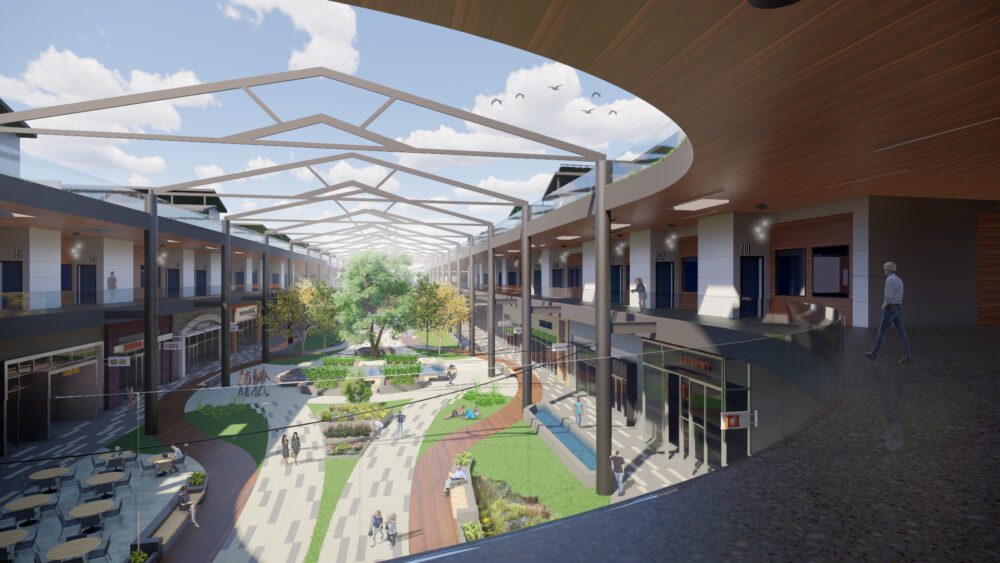
 Interior Courtyard Redevelopment Rendering
Interior Courtyard Redevelopment Rendering
While modern society looks towards the next shiny and new place to be, we often neglect to address our current spaces and how we use them. In an ever-expanding online world, shopping malls have taken a hit. With the effect of the pandemic this past year, the result has meant closures of many retailers. Our team explored concepts for redevelopment of a local mall that has seen better days.
 Current Charlestowne Mall, St. Charles, IL images (Google Images/Flickr)
Current Charlestowne Mall, St. Charles, IL images (Google Images/Flickr)
Charlestowne Mall sits in a well-trafficked, highly visible location in St. Charles, about an hour west of Chicago. But with the decline of retail and use of these spaces, there are ways to leverage current infrastructure that can revive malls like Charlestowne for the better. This design concept addresses the many challenges facing Charlestowne mall and similar suburban shopping centers. Opportunity in the scale and framework of these developments can foster an adaptive reuse approach and provide new ideas for living and working.
The initial idea absolves the single-use of Charlestowne mall by introducing living units and places to work, along with the traditional shopping/entertainment aspects. The design prioritizes greenspace and open air courtyards to both connect the development to the surrounding area and provide ample public and semi-public space.
 Mall Entry / Farmer’s Market above ground-level parking
Mall Entry / Farmer’s Market above ground-level parking
The project has re-organized the former mall into various functions, taking advantage of the multi-level layout with ample atrium/courtyard space. The lower level remains commercial, yet it introduces the idea of more office, work, and creative space to create a sense of community. Similar to malls today, there is an advantage in a large property containing theaters, amphitheaters, and other community based functions. Surrounding the structure is an expansive greenspace that resides over the top of the parking lot(s). The greenspace was envisioned as a way to connect the users of the mall with the outside community while also providing a location for playgrounds, gardens, and even a farmer’s market.
 Natural light fills the space from the front atrium-facing windows, the back patio, and from the light well at the terrace above.
Natural light fills the space from the front atrium-facing windows, the back patio, and from the light well at the terrace above.
Residential units occupy the second floor, giving privacy and a connection to the public functions below. This utilizes the vast roof space, and creates a second residential story that pops up onto the former roof level for many of the units. These dynamic floor plans enhance the livability, increase real estate value, and give the residents a more private ‘yard’ space which would have otherwise been missing in a more urban development. The change to this terrace level also supports passive building strategies like solar and ventilation, reducing the reliance on active systems.
There is opportunity for the residential units to capture the sweet spot between urban and suburban living, which is rapidly gaining popularity and investment in recent years. The spacious, open concepts leverage the high ceilings of the former retail space and allow more flexibility than cramped urban condos, but still benefit from the direct connection to the amenities and community functions within the same development.
 Private Rooftop ‘Yard’ space for residents
Private Rooftop ‘Yard’ space for residents
There is value in looking beyond what shopping malls can be. Through inserting more varied functions such as housing, work/office, and community spaces, they can be revitalized in ways that take full advantage of the existing framework but also address current needs. In the case of Charlestowne and many others, these opportunities already exist. What currently sits with ample unused space can attract new residents and businesses, and more visitors to the new community and destinations as well.
Stan’s: Where Donut & Coffee Lovers Meet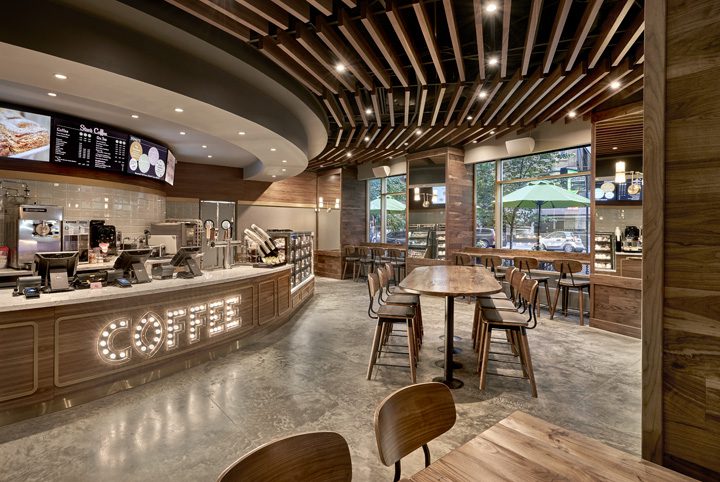
Stan’s Donuts Receives 2020 RD+D Award – Best New Prototype Runner-Up
The annual RD+D Magazine Awards honor the best in restaurant design across seven categories. We are thrilled to announce that Stan’s Donuts & Coffee has been recognized in the Best New Prototype Category – Runner-Up. Check out the RD+D March/April 2021 issue here!
A Historic Chicago Donut Moment
The first Stan’s Donuts was introduced to Chicago in 2014 after a friendship and partnership formed between Rich Labriola (of Labriola Baking Company) and Stan Berman (founder of the iconic Los Angeles donut shop that bears his name). Today, there are multiple locations of Stan’s Donuts & Coffee in the Chicagoland area that serve a vast array of freshly made donuts, delicious coffee, and whimsical experiences to a devoted community of donut lovers.
Where Donut & Coffee Lovers Meet
The client’s vision was to create a space where donut and coffee lovers unite in a comfortable atmosphere. His goal was to turn Stan’s Donuts into an enjoyable place to work or relax. The design team successfully achieved this goal by planning the space with a variety of flexible dining and counter height seats and an abundance of power outlets. A curved corner booth in Stan’s signature bubblegum pink color was designed for customers to cozy up, and has since turned into an iconic Instagram moment.
“I chose Aria for their attention to creativity and knowledge of how the restaurant business works. The design has to be able to be operable in an efficient and profitable manner. We achieved a great, usable design.” – Rich Labriola
Classy Chic Rebrand
The Stan’s Donuts & Coffee prototype design is as irresistible as their donuts and coffee. The atmosphere is chic, spacious, and refined. The design team maintained key branding elements including the bubblegum pink and sage green accent colors, the classic KitchenAid mixer wall display, and “COFFEE” marquee light. On the ceiling, walnut wood baffles radiate from the curved soffit along the front counter. Natural light pours through the wall-to-wall windows and spills onto the tabletops, dining chairs, counter seats, and plush lounge chairs – enticing customers to find their perfect spot. The walnut wood columns and marble front counter add a heightened level of elegance. Faux leather wallcovering is applied to the walls creating an air of maturity and retro ornamentation is reflected through brass details and individually lit cubbies. Overall, a variety of customer needs are met through the design and their sweet tooth is satisfied!
The Team
Our team for this project consisted of Frank Cavanaugh, Principal; Lillian Reyes-Brahar, Project Manager; Travis Vannoy, Project Coordinator; Trina Alsip, Senior Designer; and Arthur Ostrowki, Architectural Technician.
General Contractor: Kern Konstruction
Millworker: Studio Zoran
Custom Finishes: Paul Punke
Photographer: Tony Soluri
Reinventing the American Mall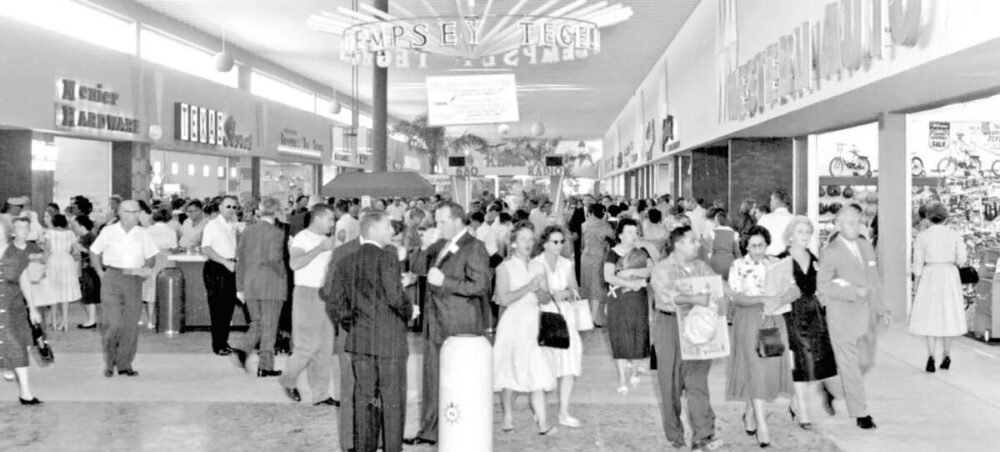
 North Star Mall Opening Day 1960 (Express News Archives)
North Star Mall Opening Day 1960 (Express News Archives)
Take a drive down the business highway in most mid-size towns, and odds are that you will inevitably pass by one of the great relics of a bygone era in American culture. The indoor mall was once the epicenter of shopping convenience and consumer capitalism in the 70’s, 80’s, and 90’s. Check out this video of the Richfield Edina shopping mall from 1956 — a flashback to this era and one of the earliest malls in the United States. Southdale 1956 – Richfield Edina Shopping Mall
Today many indoor malls are in a state of suspended animation – a gawky, mammoth lying dormant as the pulse of shopping has run back to main street, lifestyle centers, and of course online retail. Many of the flagship brands that iconized the mall era have long since flown the coop for more lucrative pastures, and the bare bones of what remains – empty shops, food courts, theatres, arcades, plazas, and stalls – sit idly awaiting reinvention.
 Photos of Mall exteriors (Abandoned Mall photos – Seph Lawless/Getty Images)
Photos of Mall exteriors (Abandoned Mall photos – Seph Lawless/Getty Images)
It doesn’t take too much digging to unearth why: simply put, the existing mall format does not meet the more holistic needs of today’s generation. This may be most notable when one compares the typical mall configuration, which relies almost entirely on the foot traffic generated by big-box stores, to the rising trend for more integrated lifestyle design, particularly the “live, work, shop, play” format. When you lump in the growing desire for walkability and sustainable urban design, it becomes very easy to scrutinize the visual, and often visceral, reaction that malls evoke; the far out, windowless behemoth sized complexes, which often float in a sea of parking lots, turn customers away through its lack of appeal and accommodation. In short, if indoor malls want to continue to be relevant, they must confront the changing epoch in front of them and seriously commit to an identity make over.
The paradox is that malls are well-practiced in reinventing themselves. New stores, kiosks, seasonal displays, and even small fast-food retailers flip in and out of plug-and-fill spaces all the time. This highlights one of the great silver-linings for malls looking to adapt: the archetype of mall spaces makes them extremely changeable by design. The more demanding work lies in integrating atypical programs to the standard mall framework, such as housing, entertainment, and recreation. At such a large scale, the role of the designers and architects in this realm cannot be understated; planners and developers must become skilled alchemists who balance the correct blend of programs and utilities to address the morphing needs of future dwellers and patrons, while also keeping costs and existing programs in check.
 Case Study: Stratford Square Mall + Aria Group
Case Study: Stratford Square Mall + Aria Group
At Aria Group, our team approached this endeavor by applying our knowledge and long standing history of experiential design and thinking about how we can alter the framework of malls to meet the needs of today. In particular, our team developed a number of proposed interventions for the Stratford Square Mall in Bloomingdale, IL, which like many malls has shared in the saga of continual decline in recent years. Regarding the strategy for revitalization, Principal Frank Cavanaugh wrote, “ the key strategy we see in giving new life to malls is turning them inside out. Carving out and demolishing underutilized gross leasable area (GLA) to create more elevated exterior tenant visibility and enhanced guest experiences”.
 Proposed Plan Concept- Southwest Entry, Stratford Square Mall
Proposed Plan Concept- Southwest Entry, Stratford Square Mall
This includes introducing lively restaurant concepts that perforate the building’s envelope, especially where they might enrichen existing mall entrances, and adding a mix of other lifestyle businesses like spas, health clubs, grocers, and medical offices. Similarly, exterior spaces and parking lots can be converted to event lawns, seasonal skating rinks, beer gardens, and other mixable entertainment spaces to bring more meaningful and attractive entertainment to the surface of the mall.
 Stratford Square Mall Southwest Entry – Before & After
Stratford Square Mall Southwest Entry – Before & After
The mission to diversify the mall’s retail base goes beyond just a facelift however. The proposition also includes the potential to infuse multi-unit residential and office spaces into the existing complex, turning the typical weekend shopping center into a vibrant community of workers and neighbors. This contemporary pairing of program is akin to the complexion of the traditional town center, where shopping is just an element in the macro-experience of everyday life. In fact, it is precisely the varied assortment of experiences that we believe will make Stratford Square such a desirable place to live, and bring patrons back to visit time and time again.
 Stratford Square Mall – Medical & Residential Site Plan Studies
Stratford Square Mall – Medical & Residential Site Plan Studies
To investigate the potential design possibilities in more depth, Aria Group also conducted a case study of a revival of the Charlestown Mall in St. Charles, Illinois. Check out our next post where we share our exploration into the merger of programs and the spatial opportunities that could re-define the future of America’s malls.
Quarantine 2020 Wrapped
 It is crazy to think it’s been over a year since the pandemic began and almost a year since our office started working remote. So much has happened. It has been the longest year, but also feels like it has flown by. As we dive into this new year and look forward to getting back to normal thanks to the vaccine, we asked our team to take a look back. They shared what they discovered about themselves while working remote, what they cooked, and, most important, what they watched on TV while stuck indoors! We all learned so much about ourselves and spent quality time with our families and close friends (if in our quarantine bubble) — many of us really slowed down and spent our time very differently than in years past. We are very much looking forward to what 2021 brings and finally getting to enjoy dinner indoors at a restaurant — with our coworkers and clients. Hope to see you soon and give you a big hug rather than just a mental hug! Check out more of what our team said here.
It is crazy to think it’s been over a year since the pandemic began and almost a year since our office started working remote. So much has happened. It has been the longest year, but also feels like it has flown by. As we dive into this new year and look forward to getting back to normal thanks to the vaccine, we asked our team to take a look back. They shared what they discovered about themselves while working remote, what they cooked, and, most important, what they watched on TV while stuck indoors! We all learned so much about ourselves and spent quality time with our families and close friends (if in our quarantine bubble) — many of us really slowed down and spent our time very differently than in years past. We are very much looking forward to what 2021 brings and finally getting to enjoy dinner indoors at a restaurant — with our coworkers and clients. Hope to see you soon and give you a big hug rather than just a mental hug! Check out more of what our team said here.

















